TSAR NICHOLAS II AND ESTONIA
By Liisi Kund

This Romanov history enthusiast decided to look into my country´s archives to learn what relationship there was between Tsar Nicholas II and Estonia.
Estonia has been part of Russia several times, the latest being 1944-1991 as part of the Soviet Union; prior to that it was 1710-1918, as of what we call “The Russian era”. Between these two time periods, we fought for our independence – the Estonian Declaration of Independence was read out in Pärnu on 23 February 1918. So for Estonia, the year 2018 is a centennial celebration, and myself I somehow feel sad, as it´s also 100 years since the deaths of the Russian Imperial family.
What connection did I find between Nicholas II and Estonia?
 The Tsar of Russia, Nicholas II was the last Grand Duke of Estonia (or Estland) and Livonia-Liivimaa ( Estonia and Latvia), and visited us several times by sea, and toured Reval (Tallinn) by land.
The Tsar of Russia, Nicholas II was the last Grand Duke of Estonia (or Estland) and Livonia-Liivimaa ( Estonia and Latvia), and visited us several times by sea, and toured Reval (Tallinn) by land.
When on 14 May, 1896 the coronation of Nicholas and Alexandra took place at the Assumption Cathedral in Moscow’s Kremlin, Estonian people celebrated too.
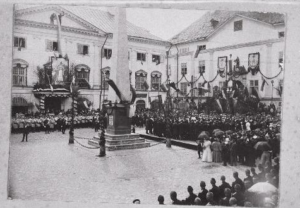
Just two years before the happily married young imperial couple was ready to welcome Tsarevich Alexei- the heir to the Russian throne, Nicholas II visited the Estonian capital on 23-26 July, 1902 (Old Style). In our waters he met with Keiser Wilhelm II to discuss politics. Tsar Nicholas II made the time to see our beautiful Reval, back then it was one of his cities.
Politically he felt it would be prudent if the Keiser did not to go on land. The Tsar was accompanied by Admiral Zinovy Rozhestvensky of the Imperial Russian Navy, and by Reval´s Governor Aleksei Bellegard who also used to be the Tsar’s vice-governor in Livonia. From 22 December, 1901 until 13 July, 1902, Nicholas II requested that his visit to Reval would be low key, which was impossible to achieve as everyone in the city was very excited to see the Tsar. They did manage to ensure the Tsar’s safety, and after the visit he received a lot of gifts to those involved and their families. The gifts included earrings, bracelets, brooches, etc.
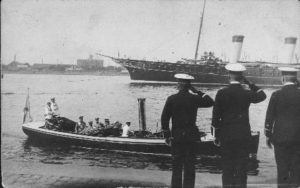
One of the places not to miss was the Rusalka (“Mermaid”) Memorial that was about to open in September, 1902. That year the bronze monument was sculpted by Amandus Adamson, to mark the ninth anniversary of the sinking of the Russian warship Rusalka, which sank en route to Finland in 1893. It was the first monument in Estonia made by an Estonian sculptor. The monument depicts an angel holding an Orthodox cross towards the assumed direction of the shipwreck. 11 officers and 166 sailors were buried in their wet graves on that day. The first stone of the base was placed on 7 September, 1901, and the angelic figure was erected one year later on 20 July, 1902. Just three days later, Nicholas II visited the site, and despite the scaffolding, he was very pleased with the work. Officially the monument was opened on 7 September, 1902.
Below are some photos of Nicholas II and Admiral Rozhestvensky visiting the place and a picture of the place as it looked on the opening day:
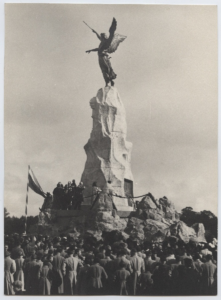



Together they also visited the Orthodox Alexander Nevsky Cathedral in Tallinn Old Town. It was built during 1894 – 1900 and named after Prince of Novgorod Alexander Nevsky. The onion shaped domes are still heretoday:
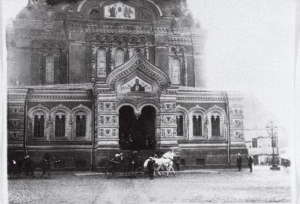
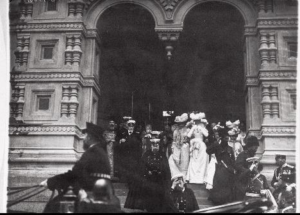
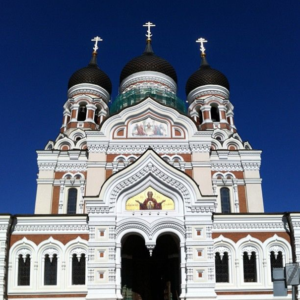
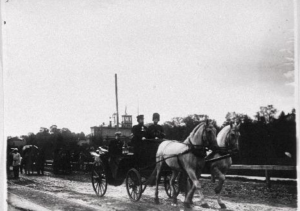
In later years the Tsar visited Estonia on several more occasions. In 1908, Nicholas II and King Edward of Britain had a three day meeting in Reval. The aim of this meeting was to conclude political and military cooperation agreements between the two countries. In the presence of both foreign ministers, an agreement was drawn up to make changes in Macedonia to weaken the Ottoman Empire.
On 5 July, 1912 Nicholas II and German Kaiser Wilhelm II had a meeting in Paldiski. The Kaiser arrived on SMS Moltke, which was the lead ship of the Moltke class battle cruisers of the German Imperial Navy. Nicholas II welcomed them on board the Russian imperial yacht The Standart, and they had a fine lunch with 50 persons. Unfortunately this diplomacy visit failed to prevent the First World War, which came two years later.

I left some interesting facts about Estonians and the Russian Imperial family for last:
-

Johannes Tiik The Tsar’s personal driver during the years 1908-1911 was also an Estonian – August Adamson.
- Johannes Tiik – was an Estonian member of Cheka, whose job was to carry out Bolshevik terror commands. In 19191 he was arrested and accused of being involved in the execution of the Romanov family in summer 1918.Johan Köler (1826–1899), an Estonian artist was considered to be the first professional painter of Estonia. He went to St. Petersburg in 1862 to work as an art school teacher. Kölerwas the art tutor of Grand Duchess Maria Alexandrovna, the daughter of Tsar Alexander II, until 1874. He also created this beautiful il painting of Dowager Empress Maria Feodorovna. This painting is hanging for public view in KUMU- The Estonian National Art Museum.

Dowager Empress Maria Feodorovna
I hope you learned something new about the Russia’s last Tsar, Nicholas II, which I decided to share oon this website with you because I´m really fond of Helen Azar’s work and her contribution in sharing pieces of Romanov family history with us.

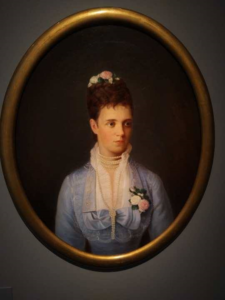
Leave a comment